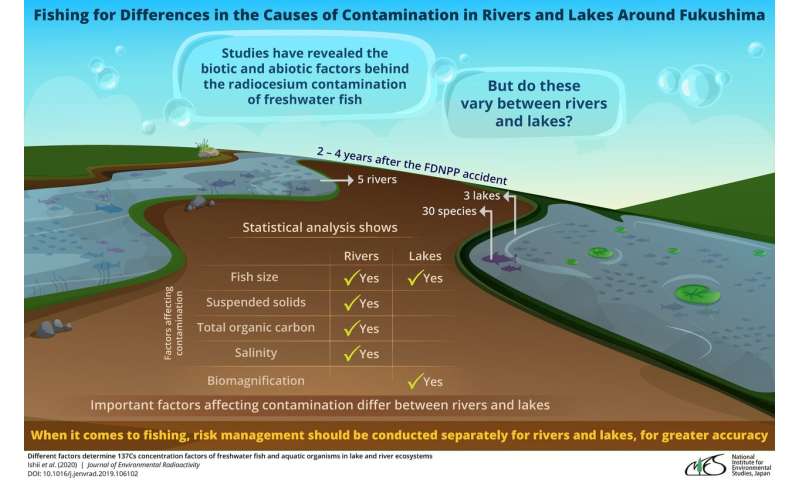
After the Fukushima nuclear power plant accident, managing environmental radionuclide contamination efficiently has become incredibly important. In light of this, a team of scientists from Miharu, Japan, have provided insights that could potentially lead to more accurate environmental risk management in the future. They have shown that the factors affecting contamination of freshwater fish differ between lakes and rivers.
In 2011, when the Fukushima Dai-ichi Nuclear Power Plant (FDNPP) accident occurred, radioactive materials leaked out into the surrounding land and water bodies, and these became highly contaminated. Consequently, to ensure no imminent risks to the health and safety of the people living in the region, fishing in lakes and rivers in the area was restricted, with no indication of when the ban will be lifted. Scientific efforts to measure the contamination levels of the natural resources of the region, and predict when it will become safe to use them, began soon after the incident and have been ongoing. Research—conducted in the aftermaths of the FDNPP incident and others that came before it, such as the Chernobyl accident—has, so far, determined the biotic and abiotic factors affecting the accumulation of radionuclides in fish. The insights thus gained have helped predict and manage contamination in the environment at Fukushima.
But what remains to be studied is whether these underlying factors differ among ecosystems, and if they do, then how. Addressing this question, a group of scientists from the National Institute for Environmental Studies, Japan, led by Dr. Yumiko Ishii, analyzed the monitoring data of 30 species of fish and aquatic organisms from five rivers and three lakes in Fukushima. This they did two to four years after the FDNPP accident. In their study, published in Journal of Environmental Radioactivity, they statistically correlated radiocesium measurements with a number of biotic and abiotic factors. Radiocesium, particularly cesium-137, has a long half-life, or decay period, of about 30 years, and is the primary contaminant in the area. As Dr. Ishii explains: "After the FDNPP accident, radiocesium has become a major contaminant in Fukushima, and the risk of exposure to its radiation has become a topic of considerable concern."
The factors that the scientists considered were fish characteristics—feeding habit, body size, and habitat; and water chemistry—salinity, total organic carbon, and suspended solids concentration. Their analysis revealed that the factors affecting radiocesium levels in riverine organisms did not necessarily influence radiocesium levels in organisms from the lake. Specifically, suspended solids concentration, total organic carbon, and salinity were significant factors in rivers, but not in lakes. Feeding habits had a major influence in the case of piscivorous fish in lakes, but not in rivers; this was evident from the fact that significant biomagnification of radiocesium (i.e., the increase in its concentration as it travels up the food chain) was observed only in lakes. Lastly, fish size had noticeable influence in both lakes and rivers.
Overall, these findings show that biotic and abiotic factors affecting radionuclide accumulation in fish are clearly dependent on the ecosystem—and they differ between lakes and rivers. The findings of this study could potentially lead to the implementation of better and more efficient environmental disaster response strategies in the future. As Dr. Ishii concludes, "Considering lakes and rivers separately when looking at the effects of radioactive contamination will lead to better and more accurate environmental risk management."
More information: Yumiko Ishii et al, Different factors determine 137Cs concentration factors of freshwater fish and aquatic organisms in lake and river ecosystems, Journal of Environmental Radioactivity (2019). DOI: 10.1016/j.jenvrad.2019.106102
Provided by National Institute for Environmental Studies
No comments:
Post a Comment